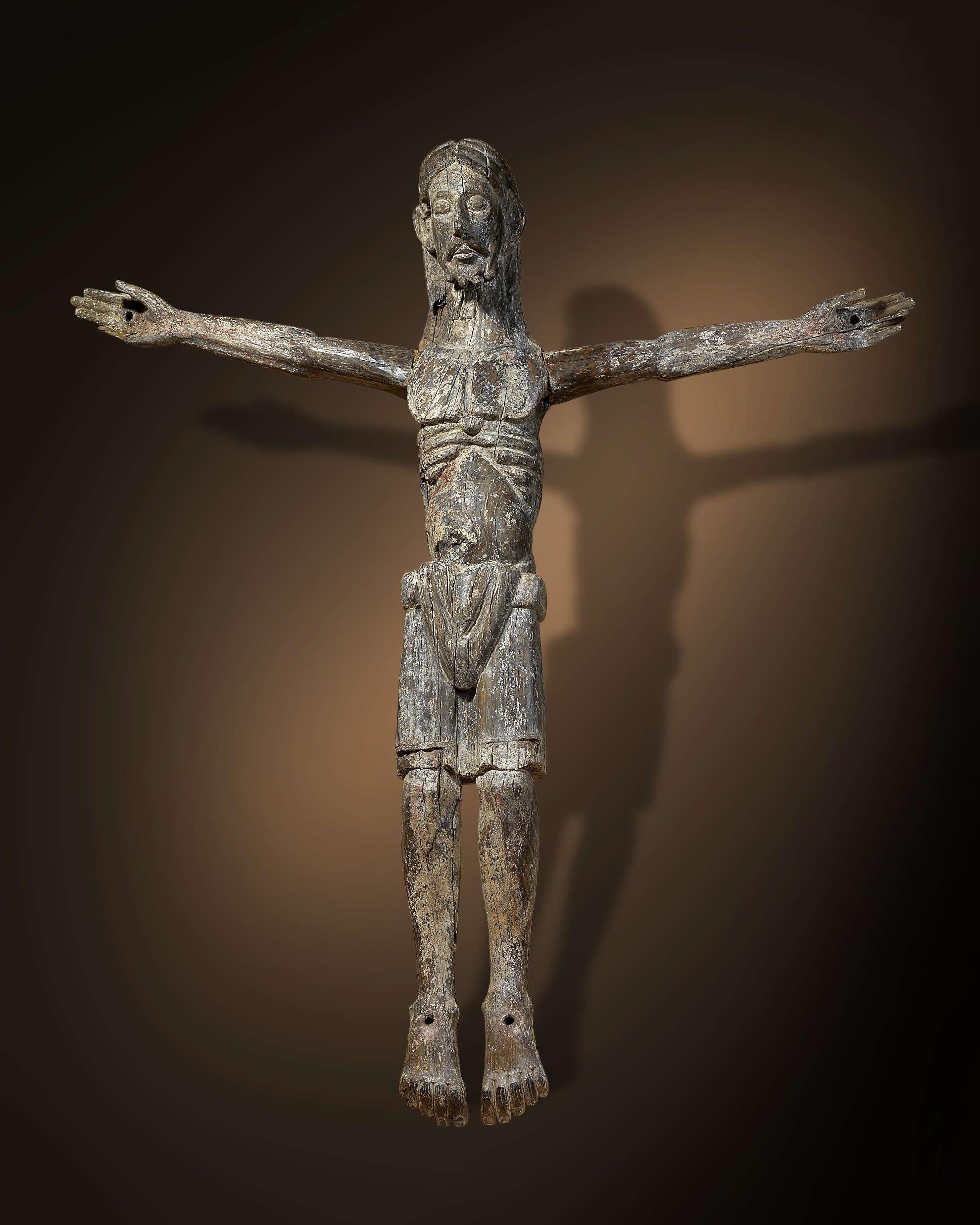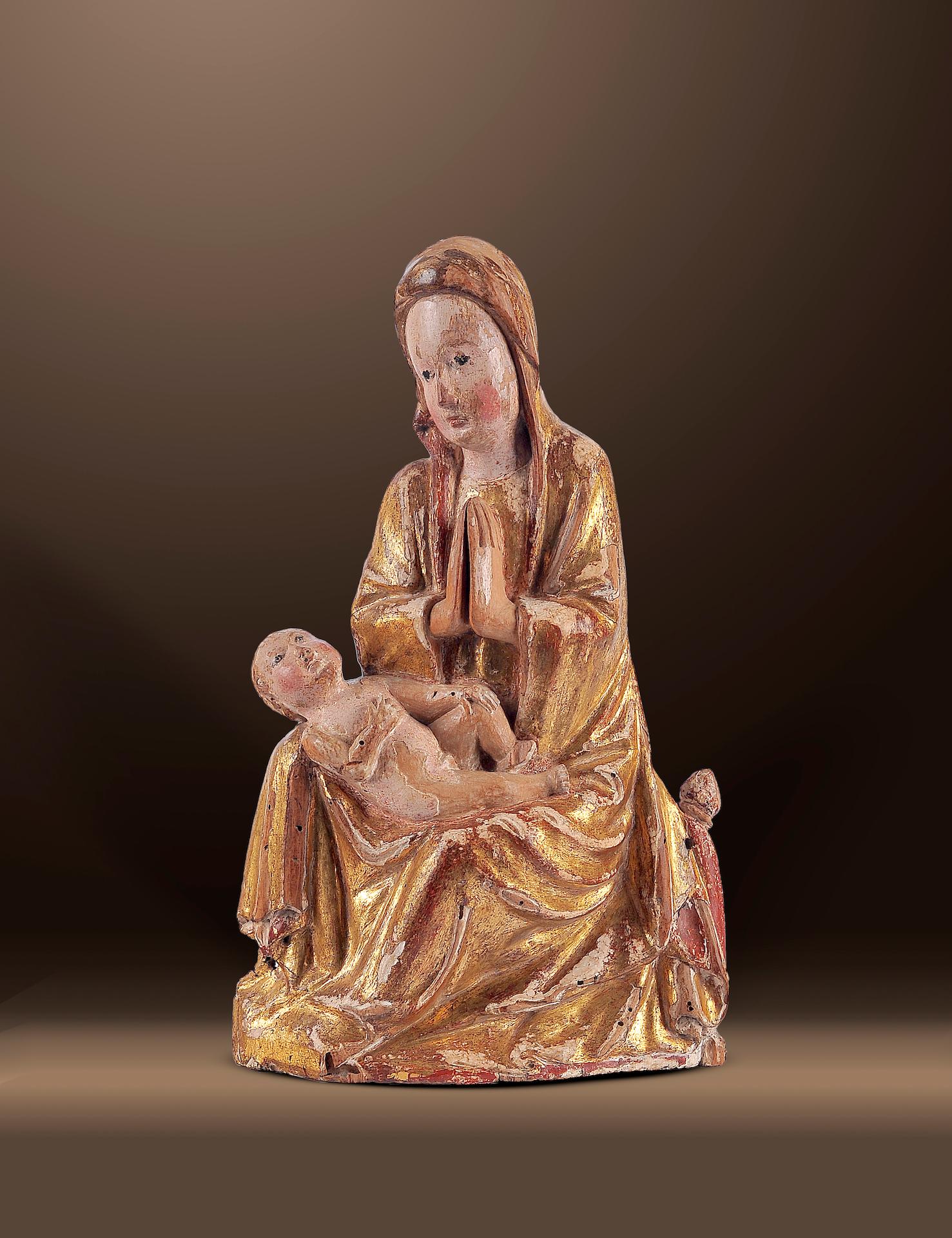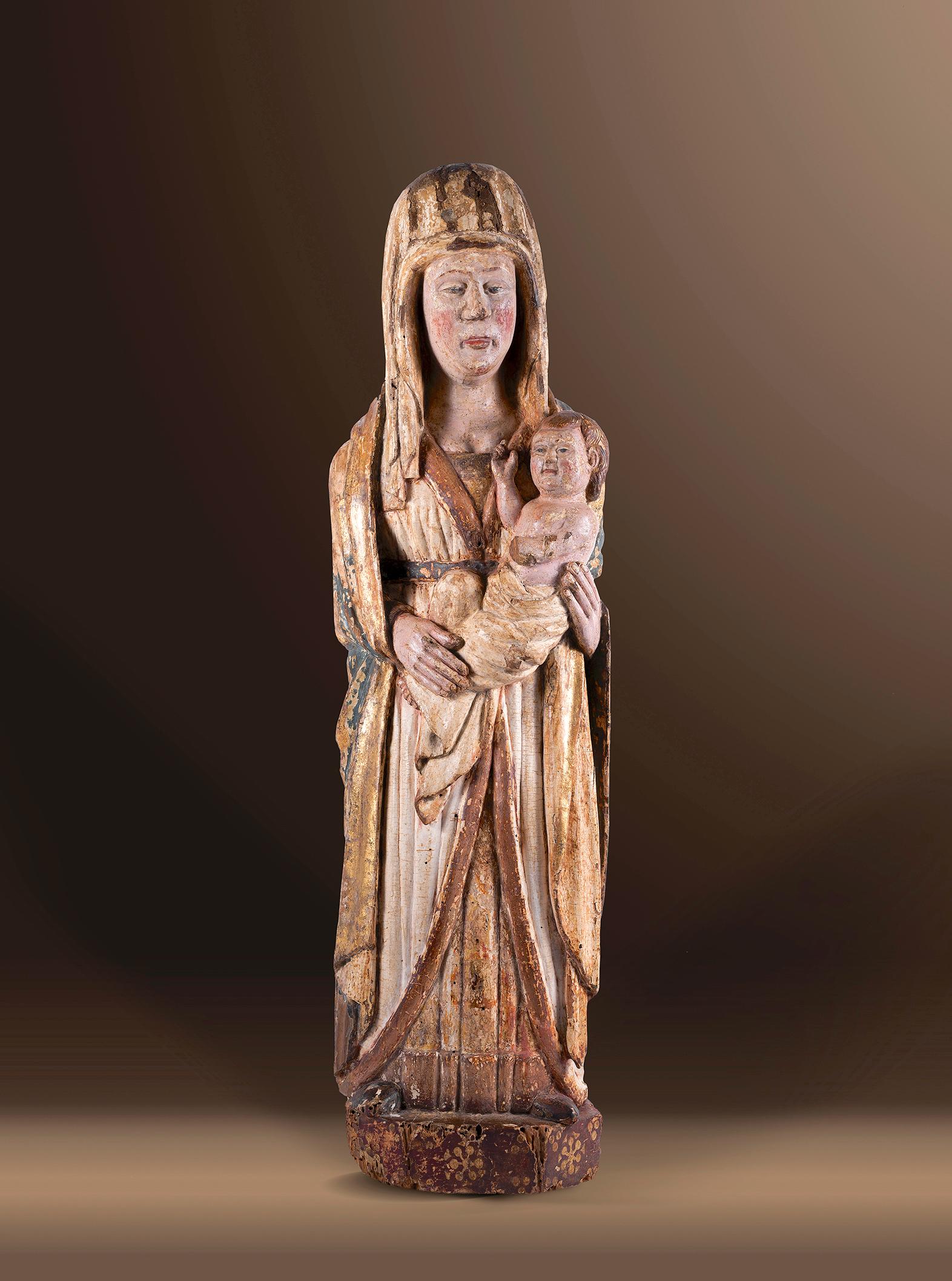Want more images or videos?
Request additional images or videos from the seller
1 of 11
UnknownRomanesque Madonna - 1175/801175/80
1175/80
About the Item
ROMAN MADONNA
“Sedes Sapientiae”
Auvergne
Around 1175/80
Pine wood
Polychrome remains
Height 44 cm
This depiction of the Madonna is a masterfully carved, extremely early figure made of pine or stone pine wood in an exquisite state of preservation. It was made in the French Auvergne around 1175. The compact size (approx. 35 cm) as well as the high quality indicate its production for the precious altar shrine of a Romanesque church.
The Madonna corresponds to the Sedes Sapientiae type: Mary as the throne of divine wisdom. She is seated on a magnificently carved two-tiered raised throne and enthroned in the center is the infant Jesus on her lap, facing frontally as is his mother. In the left hand it holds a book, while it has raised the right hand in the proclamation gesture. The figure is symmetrically constructed; the meticulous frontality clearly shows the early period of this impressive depiction. The faces are vividly expressively carved, with large, wide-open eyes and deeply notched upper eyelids. The stern expression is accentuated by the prominent nose, which seamlessly blends into the sharp ridges of the eyebrows. Mary’s full lips are slightly open, while those of the child are pursed. A reference to Mary’s role as mediator, communicating with people and, as a result, delivering their intercessions to Jesus?
The carefully crafted surfaces suggest the drapery folds only in shallow relief, typical of the 12th century period. Mary’s veil cloth is laid smoothly over her head, with indentations on the underside. In these places were probably appliqués – possibly precious stones. The folds are bulging around her forearms; on the upper body, rounded incised marks indicate an attempt to depict a thin robe. This falls in idiosyncratic configurations around the smooth kneecaps to hit the ground in parallel fashion. Here the textile appears thick like luxurious brocade fabric; a supposedly dense border falls between Mary’s feet as the only asymmetrical element in suggested zigzag folds. The doughy-soft folds over the rounded forms seem like the transfer of a two-dimensional painting technique to the three-dimensional carved object. Especially icon depictions of Byzantine chrysographic technique and enamel work are recalled here.
Traces of polychromy have survived in the notched grooves, indicating that the Madonna’s robe was dyed green and her cloak blue. Light red traces of color on the child’s dress refer to its red coloring, and in the tradition of Christian color symbolism this could refer to the imminent Passion of Christ. However, it could also be bolus – an alumina silicate – that serves as a substrate for later gold leaf gilding. The throne is covered with remnants of a dark, oxidized layer, indicating earlier silver plating. This is also symmetrically structured: A group of three narrow columns, each ending in arcaded arches, flanks the depiction of the Madonna in a majestic manner. These arcades each support a panel with an elliptical decorative ornament inscribed in a thick rectangular frame. The reference to contemporary luxurious furniture is also found in more of these early Madonna depictions.
For example, the so-called Madonna of Orcival, or Vierge en Majesté, is stylistically very related to the specimen presented here. Both testify to high, masterful quality, although the sculpture described is characterized by greater elegance and was constructed in a less block-like, rigid manner. The child’s bent-over posture proves this in a playful manner and also makes the depiction seem more viewer-oriented. Furthermore, it is already part of the later typical tradition of not merely gilding the bodies of the figures, as in the beginning, but also dressing them in appealingly colorful polychrome.
- Creation Year:1175/80
- Dimensions:Height: 17.33 in (44 cm)Width: 7.88 in (20 cm)
- Medium:
- Movement & Style:
- Period:
- Condition:Very good condition for the age.
- Gallery Location:Wien, AT
- Reference Number:1stDibs: LU114326678962
About the Seller
No Reviews Yet
Vetted Seller
These experienced sellers undergo a comprehensive evaluation by our team of in-house experts.
Established in 1986
1stDibs seller since 2019
Typical response time: 12 hours
- ShippingRetrieving quote...Ships From: Wien, Austria
- Return PolicyA return for this item may be initiated within 14 days of delivery.
More From This SellerView All
- Corpus Christi 1150/70Located in Wien, WienCorpus Christi around 1150/70 Southern France or Catalonia carved oak wood height 109 cm, width 96 cm Remains of polychromyCategory
15th Century and Earlier Gothic Figurative Sculptures
MaterialsWood
- Sainte CatherineLocated in Wien, WienSt. Catherine Cologne Around 1370/80 Carved lime wood Original version Height 49,5 cmCategory
15th Century and Earlier Gothic Figurative Sculptures
MaterialsWood
- Sitting MadonnaLocated in Wien, WienSitting Madonna Central Italy/Tuscany or Marche Around 1420 Poplar wood carved Original version Height 31 cm Charming Madonna sculpture from the heyday of the Soft or International...Category
15th Century and Earlier Gothic Figurative Sculptures
MaterialsWood
- Madonna around 1300Located in Wien, WienEXTREMELY RARE MADONNA Lake Constance area Around 1300 Carved votive wood Original, polychrome version Height 59 cm Provenance: Swiss private collection This Madonna figure ...Category
15th Century and Earlier Gothic Figurative Sculptures
MaterialsWood
- Late Gotic Relief "Adoration of the Magi"Located in Wien, WienLATE GOTIC RELIEF “Adoration of the Magi Lower Rhine Around 1500 Oak wood, plastically carved Original, polychrome version Height 51 cm, widt...Category
16th Century Gothic Figurative Sculptures
MaterialsWood, Oak
- Virgin and ChildLocated in Wien, WienOUTSTANDING MADONNA Bavaria Around 1515/20 Lime wood carved Original, polychrome version Height 60 cm This masterfully carved, full-round Madonna was created around 1515-20 in...Category
16th Century Medieval Figurative Sculptures
MaterialsWood
You May Also Like
- Saint John Evangelist. Carved oak.Located in PARIS, FRBeautiful Saint-Jean in oak wood carved from the Gothic period. Standing, his left leg bent, he is dressed in a dress tied at the waist with a belt and a coat with a chest strap. The...Category
15th Century and Earlier Gothic Figurative Sculptures
MaterialsWood
- A Spanish Gothic Statue of Saint Mary Magdalene, Late 15th CenturyLocated in Bruges, BEDescription: A Spanish Gothic Statue of Saint Mary Magdalene, Late 15th Century, polychromed wood Statue: Saint Mary Magdalene Object Type: Statuet...Category
15th Century and Earlier Gothic Figurative Sculptures
MaterialsWood
- Polychrome Virgin of the Annunciation - CataloniaLocated in PARIS, FRLarge catalan Virgin of the Annunciation in polychrome wood. Our Virgin is represented in the phase of the Conturbatio, Mary expresses her amazement a...Category
15th Century and Earlier Gothic Figurative Sculptures
MaterialsWood
- Sedes Sapientiae. Mosan Virgin with Child.Located in PARIS, FRLarge Virgin and Child in oak from the end of the 13th century or beginning of the 14th century. The plasticity of the faces and of Christ evoke the 13th century (the face of the Virgin evokes the face of the Romanesque Sedes Sapientiae...Category
15th Century and Earlier Gothic Figurative Sculptures
MaterialsWood
- Enthroned VirginLocated in PARIS, FRRare wooden polychrome Virgin and Child from the French Catalonia region representing a Virgo Lactans (nursing Madonna). Before this discovery, only 3 medieval nursing madonnas were ...Category
15th Century and Earlier Gothic Figurative Sculptures
MaterialsWood
- One on a chariot Medieval Tile Gypsum CastLocated in Slovak Republic, SKGypsum cast - medieval tile, from Central Europe. Adjusted in a frame, ready to hang or install.Category
15th Century and Earlier Gothic Figurative Sculptures
MaterialsGesso
Recently Viewed
View AllMore Ways To Browse
Antique Madonna
Type 80
Dark Blue Purse
Gold Compact Purse
Bent Wood Art
Lip Sculptures
Dark Green Purse
Wisdom Sculpture
15th Century Stone Sculpture
Sculpture Head Roman
Roman Head Sculpture
Round Blue Sculpture
Gothic Stone
15th Century Sculpture Head
Roman Wood Sculptures
Deep Red Large Sculptures
Large Stone Sculpture Gold
Gothic Green



